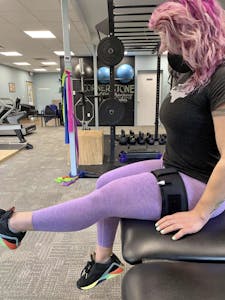Woodfin is now offering blood flow restriction training with FDA approved H+ cuffs.
What is Blood Flow Restriction?
Exactly how it sounds - reduce blood flow to an extremity for short periods of time to stimulate the body to release beneficial hormones that aide in strength, recovery, and pain modulation.
The process of utilizing a piece of equipment to reduce the amount of blood flow briefly and intermittently to a limb.
Benefits of BFR: creates an intense environment for the muscles, while minimizing stress on tendons, ligaments, and joints.
BFR is typically utilized with no weights or low weight strength training to elicit the benefits of heavy weight training.
Reduces the amount of physical/mechanical stress on muscles, ligaments, and joints, making it an excellent option for those with arthritis, joint pain, post-operative rehabilitation, and injuries.
Who Can Benefit from Blood Flow Restriction?
Nearly everyone can benefit from BFR. However, BFR can be especially beneficial for people who are unable to lift heavy weights secondary to age, injury, osteoporosis, arthritis, pain, etc.
Reduces pain signal pathways during and up to 24 hours post-implementation. Allows for clinicians to implement exercises sooner and more rapidly during the rehabilitation process. May allow the patient to tolerate manual therapies such as gentle joint mobilizations, PROM, IASTM, during the treatment session. May reduce muscle guarding post-implementation, which may lead to improved soft tissue tolerance. Patients may also be able to participate in functional activities more readily with the reduced pain from BFR.
Athletes
Typical training regimen of 70% 1 Repetition Maximum (1RM), or more, to stimulate type 2 muscle fibers and improve strength/hypertrophy. BFR allows athletes to use lighter weights, decrease the stress on their tendons and joints, and allow their connective tissues to recover, all while stimulating muscle mass and strength.
Research:
- Clark, B. C., et al. (2011). Relative safety of 4 weeks of blood flow-restricted resistance exercise in young, healthy adults. Scandinavian Journal of Medicine, Science, and Sport. 21: 653-662.
- Fujita, S., Abe, T., Drummond, M. J., Cadenas, J. G., Dreyer, H. C., Sato, Y., Volpi, E. & Rasmussen, B. B. (2007). Blood flow restriction during low-intensity resistance exercise increases S6K1 phosphorylation and muscle protein synthesis. J Appl Physiol 103: 903 - 910.
- Counts, B. R., et al. (2016). Influence of relative blood flow restriction pressure on muscle activation and muscle adaption. Muscle & Nerve. 53: 438–445.
- Ferraz, R. B., Gualano, B. & Rodrigues, R. (2018). Benefits of Resistance Training with Blood Flow Restriction in Knee Osteoarthritis. Medicine & Science in Sports & Exercise. 50(5):897-905.




